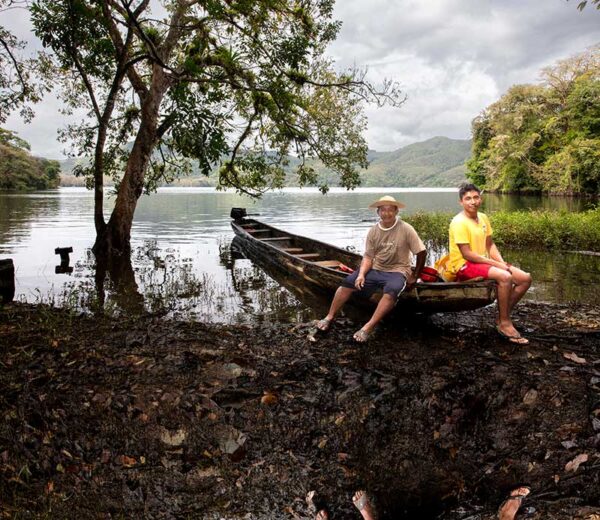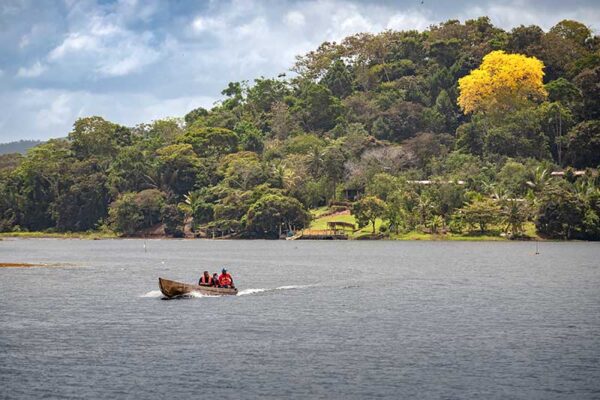Ecosystem benefits: a gift from nature
The Food and Agriculture Organization of the United Nations (FAO) is clear in describing the benefits that nature gives us: […]
The Food and Agriculture Organization of the United Nations (FAO) is clear in describing the benefits that nature gives us: “ecosystem services make human life possible, for example, by providing nutritious food and clean water; regulating disease and climate; supporting crop pollination and soil formation; and offering recreational, cultural, and spiritual benefits“.
In the Panama Canal Watershed (PCWC), this is a fact that does not go unnoticed; in its entrails is stored the water that drives the country’s development. This is where the liquid is obtained to supply more than 50% of the country’s population, guarantee canal operations, as well as agricultural and industrial activities. However, this is not the only thing that this great ecosystem provides.
Between the intense greenery of the forest and the crystalline waters of lakes, rivers and streams, there are those services that nature provides and whose benefits reach us all. This is the scenario where the residents of the communities of the Canal watershed, main actors of the environmental conservation actions, enjoy them as a kind of reward for the noble work they develop.
The catch of the day
Paula María Rodríguez is a working woman, and you can see it in her hands. When the first rays of sunlight reach Gatun Lake, she is already paddling in her small canoe towards strategic points of this body of water. There, she will obtain the fish to feed her family and sustain a small business selling this product, which she runs in the community of Pueblo Nuevo de Ciricito (Province of Colón).
For this fisherwoman, the contact with nature represents, besides a way of earning a living, a satisfaction that she never hides, “it is a charm for me to be in the water fishing, I feel happy”, she assured with the optimism of someone who has found an alternative to face the challenges that she maintains at home.
It is not for less, to Paula the nature returns her effort with the jacks, bream, colosomas and snook, among other species of fish that serve her to pay the university studies of her two daughters and the expenses of her son, affected by a disability, that forces him to take daily medication.

Visitors are welcome
In the CHCP, many communities open their doors to travelers eager to learn about the culture, history and traditions of people who live in harmony with the environment. There, the tourist offer is different.
Ismael and Jorge Muñoz are father and son who, in addition to blood ties, share a passion for tourism: both enjoy serving visitors who come to their village, Quebrada Ancha del Lago Alhajuela. Many arrive attracted by the natural wealth of this site, located in the Chagres National Park, where they enjoy the ecological trail of the Ermitaño Hummingbird.
Ismael represents those pioneer settlers in the idea of transforming their town into a site for the reception of tourists, while Jorge, the new blood willing to take the baton and move forward, as he is already the president of the tourism committee, besides being part of the Youth Network for the Environment and the Canal Watershed.
The scenic beauty of the place, its degree of conservation and the historical elements present in the area made the desires of a group of locals, who saw tourism as an opportunity to bring extra income to their homes, come to fruition.
Both say that the idea gradually gained followers and today most of the people are involved. As for the work, there is no segregation by sex, since all have learned and carry out the different tasks, ranging from maneuvering the cayuco where they transport the tourists, to being guides on the trail, to cooking the food that will be offered at the end of the tour.
Visitors from all continents have come to this point of Lake Alhajuela seeking to be in contact with nature, to learn about the daily activities of the farmers, but in strict compliance with the rules, “here, we are aware that we live in a protected area and of the importance of protecting the resources,” said Jorge.
Water highways
Facilitating the movement of people and goods between different points is another of these services that nature provides. It is an activity that for some people represents a way to make a living, because in the communities located on the shores of the Canal’s lake system, boats and canoes play a fundamental role.
Armando Rodriguez is one of those transporters; it is a trade he knows perfectly, because although he is a young man of 23 years, since he was 12 years old, he already knew how to guide a boat and began to provide the service among his acquaintances.
Gatun Lake offers the opportunity to transport residents, but at the same time presents a series of conditions that captivate visitors who come to these communities attracted to the possibility of fishing in the lake, for the scenic beauty, nature, biodiversity, rivers and other attractions that motivate them to use these transports and make the tours.

Services that benefit us all
Karina Vergara, manager in charge of the Panama Canal’s Environmental Policy and Protection Division, explained that ecosystem services are all those that human beings receive, either by the processes, dynamics or function of ecosystems.
She added that they can be grouped into four types of services:
- Provisioning: These are those that have to do with what we consume, for example: food, medicinal plants, and water that is used for consumption and for productive processes.
- Cultural: They are related to the benefits provided by nature with its scenic beauty that serves as a source of relaxation, and, in other cases, for the establishment of green businesses such as ecotourism.
- Regulation: These services are obtained from the regulation of ecosystem processes, for example: water quality, air purification, soil fertility.
- Support: These are the services that constitute the foundation for the rest of the services because they facilitate their existence, for example, the areas where plants and animals live.
The Panama Canal, through the work carried out with the different participatory platforms and the joint work with the rest of the institutions, has identified those services that are most used by the communities of the watershed, to determine what they need or what adds value to them, said the specialist.
In this sense, she added that, as part of the socio-environmental management developed in the watershed, progress is being made in the development of increasingly integral projects; that is, not only aimed at caring for The Canal seeks to accompany these initiatives with business opportunities in which people directly perceive the benefits provided by nature, which will produce a synergy between the initiatives.
For the Panama Canal, the communities of the Panama Watershed are fundamental for water conservation, and therefore promotes sustainable development in these areas, so that the benefits they provide continue to reach all Panamanians.